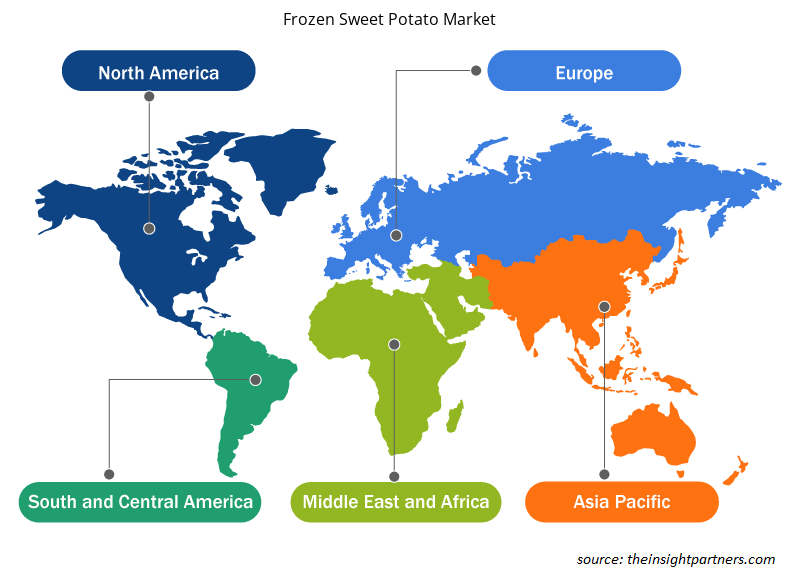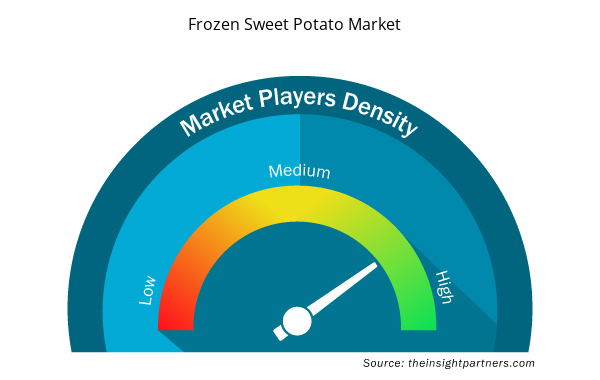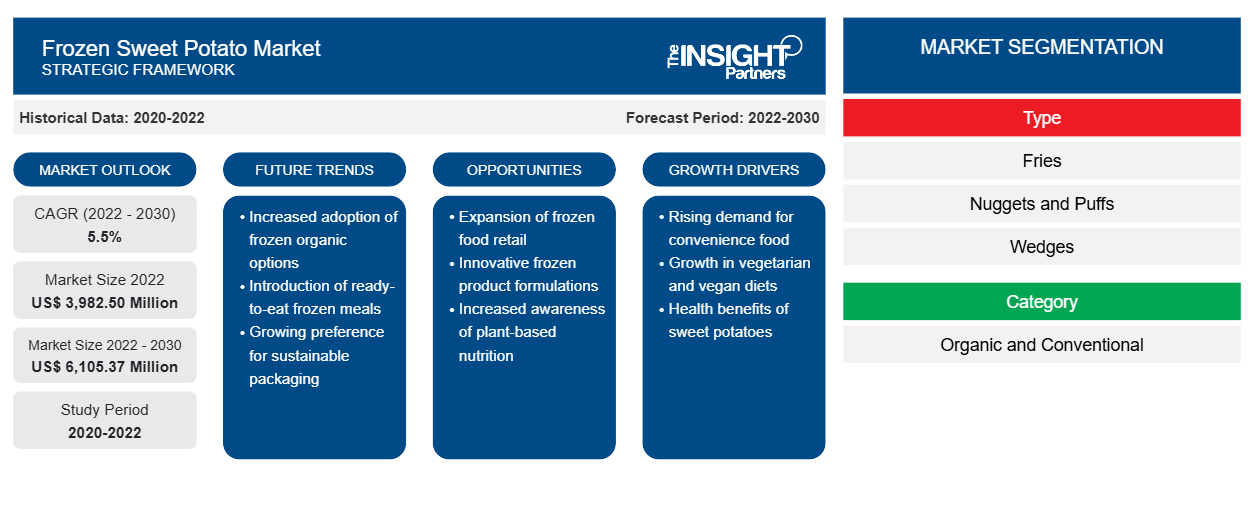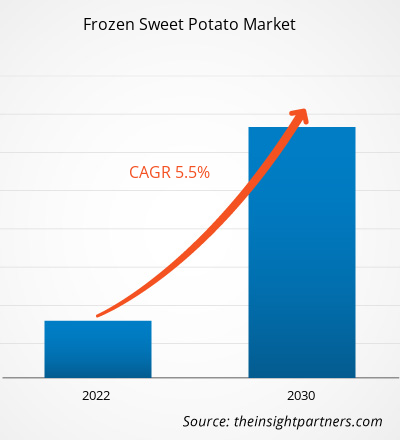[Forschungsbericht] Der Markt für gefrorene Süßkartoffeln wurde auf 3.982,50 Millionen US-Dollar im Jahr 2022 und soll bis 2030 6.105,37 Millionen US-Dollar erreichen; der Markt soll von 2022 bis 2030 eine durchschnittliche jährliche Wachstumsrate (CAGR) von 5,5 % verzeichnen.CAGR of 5.5% from 2022 to 2030.
Markteinblicke und Analystenansichten:
Tiefgekühlte Süßkartoffelprodukte bieten eine praktische und vielseitige Möglichkeit, dieses nahrhafte Wurzelgemüse in eine Mahlzeit zu integrieren. Ob in Form von Pommes Frites, Wedges, Nuggets, Rösti oder anderen Produkten, diese Tiefkühlprodukte bieten eine zeitsparende Lösung für vielbeschäftigte Menschen, die ihre Ernährung gesund ergänzen möchten. Der veränderte Lebensstil der Menschen und hektische Arbeitspläne treiben die Nachfrage nach Fertiggerichten an. Die Menschen tendieren zu Produkten, die ihnen Komfort bieten und ihnen helfen, Zeit zu sparen. Diese Faktoren treiben die Nachfrage nach Tiefkühlkost an. Tiefkühlkost lässt sich zu Hause einfach und ohne Zeitaufwand zubereiten. Darüber hinaus ist sie länger haltbar und leicht zu lagern. Tiefgekühlte Süßkartoffeln werden aufgrund ihres vielseitigen Geschmacks und ihrer knusprigen Textur bei jüngeren Menschen und Kindern zu beliebten Snacks. Die steigende Nachfrage nach Tiefkühlkost und die zunehmende Beliebtheit von tiefgekühlten Süßkartoffelprodukten treiben also das Marktwachstum an.
Wachstumstreiber und Herausforderungen:
Das Aufkommen des E-Commerce hat zu erheblichen Veränderungen in der Art und Weise geführt, wie Menschen einkaufen und Lebensmittel kaufen. Die zunehmende Verbreitung von Smartphones und des Internets, der schnelle Zugang zu neuen Technologien, die steigende Kaufkraft und die Bequemlichkeit, die Online-Einzelhandelsplattformen bieten, gehören zu den Schlüsselfaktoren, die den E-Commerce stärken. Die Menschen bevorzugen zunehmend Online-Einzelhandelsplattformen für den Kauf von Tiefkühlkost. Laut dem American Frozen Food Institute stiegen die Online-Verkäufe von Tiefkühlkostprodukten, einschließlich Tiefkühlsnacks, im Jahr 2020 um 75 %. Die Online-Verkäufe von Lebensmitteln und Getränken stiegen während des COVID-19-Ausbruchs aufgrund der Schließung von stationären Geschäften und der Verhängung mehrerer sozialer Beschränkungen durch Regierungen verschiedener Länder auf der ganzen Welt erheblich an. Mit der zunehmenden Verbreitung des E-Commerce in mehreren Regionen verstärken auch Hersteller von Tiefkühlkost wie Conagra Brands Inc., McCain Foods Ltd. und Aviko BV ihre Online-Präsenz, indem sie Produkte über Amazon, Tesco und andere bekannte E-Commerce-Plattformen verkaufen. Die zunehmende Nutzung von E-Commerce-Plattformen beseitigt die Abhängigkeit von Offline-Einzelhandelsgeschäften. Daher wird erwartet, dass die steigenden Umsätze bei Tiefkühlsnacks über E-Commerce-Plattformen im Prognosezeitraum lukrative Möglichkeiten für ein Wachstum des Marktes für tiefgekühlte Süßkartoffeln schaffen werden.
Kühlkettenlogistik ist für den reibungslosen Ablauf und die weltweite Verbreitung des Tiefkühlsüßkartoffelgeschäfts unerlässlich. In mehreren Entwicklungsländern in beiden Regionen fehlt jedoch immer noch die Kühlketteninfrastruktur, sodass sie den Verbrauchern keine sicheren Tiefkühlprodukte anbieten können. Obwohl Tiefkühlprodukte eine lange Haltbarkeit haben, ist ihr Abfall unvermeidlich, wenn sie während der Handhabung, des Transports und der Lagerung nicht bei den angegebenen niedrigen Temperaturen gelagert werden, was zu verunreinigten Produkten führt. Daher behindert das Risiko des Abfalls von Tiefkühlprodukten aufgrund der fehlenden Kühlketteninfrastruktur in Entwicklungsländern das Wachstum des Marktes für Tiefkühlsüßkartoffeln.
Passen Sie diesen Bericht Ihren Anforderungen an
Sie erhalten kostenlos individuelle Anpassungen an jedem Bericht, einschließlich Teilen dieses Berichts oder einer Analyse auf Länderebene, eines Excel-Datenpakets sowie tolle Angebote und Rabatte für Start-ups und Universitäten.
- Holen Sie sich die wichtigsten Markttrends aus diesem Bericht.Dieses KOSTENLOSE Beispiel umfasst eine Datenanalyse von Markttrends bis hin zu Schätzungen und Prognosen.
Berichtssegmentierung und -umfang:
Die globale Marktanalyse für tiefgekühlte Süßkartoffeln wird nach Typ, Kategorie, Endverbraucher und Geografie kategorisiert. Nach Typ ist der Markt in Pommes frites, Nuggets und Puffs, Wedges, Hashbrowns und andere unterteilt. Nach Kategorie ist der Markt in Bio und konventionell unterteilt. Nach Endverbraucher ist der Markt in Gastronomie und Lebensmitteleinzelhandel unterteilt. Nach Geografie ist der Markt grob in Nordamerika, Europa, Asien-Pazifik (APAC), Naher Osten und Afrika (MEA) sowie Süd- und Mittelamerika unterteilt. Der Markt in Nordamerika ist weiter in die USA, Kanada und Mexiko unterteilt. Der europäische Markt ist weiter in Deutschland, Frankreich, Großbritannien, Italien, Spanien und den Rest von Europa unterteilt. Der Markt im Asien-Pazifik-Raum ist weiter in China, Indien, Japan, Australien, Südkorea und den Rest des Asien-Pazifik-Raums unterteilt. Der Markt im MEA ist weiter in Südafrika, Saudi-Arabien, die Vereinigten Arabischen Emirate und den Rest des MEA unterteilt. Der Markt in Süd- und Mittelamerika wird weiter unterteilt in Brasilien, Argentinien und den Rest von Süd- und Mittelamerika.
Segmentanalyse
Basierend auf der Kategorie wird der Markt für tiefgefrorene Süßkartoffeln in konventionelle und biologische unterteilt. Das konventionelle Segment hält einen bedeutenden Marktanteil an tiefgefrorenen Süßkartoffeln, und biologische Süßkartoffeln werden im Prognosezeitraum voraussichtlich erheblich wachsen. Bio-Tiefkühl-Süßkartoffelprodukte werden aus biologisch angebauten Süßkartoffeln hergestellt. Die Nachfrage nach tiefgefrorenen Süßkartoffeln wird auf die wachsende Vorliebe der Verbraucher für gesündere und umweltbewusstere Lebensmittel zurückgeführt. Bio-Produkte werden als frei von synthetischen Pestiziden und Chemikalien wahrgenommen, was dem steigenden Bewusstsein für gesundheitliche Bedenken im Zusammenhang mit synthetischen Chemikalien entspricht. Verbraucher suchen zunehmend nach Produkten, die sowohl praktisch als auch ernährungsphysiologisch vorteilhaft sind.
Regionale Analyse:
Von allen großen Regionen dominierte Nordamerika im Jahr 2022 den Markt für gefrorene Süßkartoffeln. Der Markt in dieser Region wurde im Jahr 2022 auf 1.240,95 Millionen US-Dollar geschätzt. Europa ist der zweitgrößte Marktteilnehmer und hält etwa 29 % des Marktanteils an gefrorenen Süßkartoffeln. Die Markttrends für gefrorene Süßkartoffeln in Nordamerika werden auf den wachsenden Konsum von Süßkartoffeln, die steigende Nachfrage nach Fertiggerichten, zunehmende Initiativen zur Produktförderung und das wachsende Interesse an gesunden Lebensmitteln zurückgeführt. Der Markt für Süßkartoffeln in Nordamerika ist in den vergangenen Jahren deutlich gewachsen und wird auch in Zukunft weiter wachsen.
Branchenentwicklungen und zukünftige Chancen:
Nachfolgend sind verschiedene Initiativen der wichtigsten Akteure auf dem Markt für tiefgefrorene Süßkartoffeln aufgeführt:
- Im März 2022 kündigte KUK die Einführung tiefgefrorener Süßkartoffelchips in Dubai, VAE, an; Ziel der Markteinführung war die Erweiterung des Produktportfolios und der Kundenbasis.
Regionale Einblicke in den Markt für gefrorene Süßkartoffeln
Die regionalen Trends und Faktoren, die den Markt für gefrorene Süßkartoffeln während des gesamten Prognosezeitraums beeinflussen, wurden von den Analysten von Insight Partners ausführlich erläutert. In diesem Abschnitt werden auch Marktsegmente und Geografie für gefrorene Süßkartoffeln in Nordamerika, Europa, im asiatisch-pazifischen Raum, im Nahen Osten und Afrika sowie in Süd- und Mittelamerika erörtert.

- Erhalten Sie regionale Daten zum Markt für gefrorene Süßkartoffeln
Umfang des Marktberichts über gefrorene Süßkartoffeln
| Berichtsattribut | Details |
|---|---|
| Marktgröße im Jahr 2022 | 3.982,50 Millionen US-Dollar |
| Marktgröße bis 2030 | 6.105,37 Millionen US-Dollar |
| Globale CAGR (2022 - 2030) | 5,5 % |
| Historische Daten | 2020-2022 |
| Prognosezeitraum | 2022–2030 |
| Abgedeckte Segmente | Nach Typ
|
| Abgedeckte Regionen und Länder | Nordamerika
|
| Marktführer und wichtige Unternehmensprofile |
|
Marktteilnehmerdichte für gefrorene Süßkartoffeln: Auswirkungen auf die Geschäftsdynamik verstehen
Der Markt für gefrorene Süßkartoffeln wächst rasant, angetrieben von der steigenden Nachfrage der Endverbraucher aufgrund von Faktoren wie sich entwickelnden Verbraucherpräferenzen, technologischen Fortschritten und einem größeren Bewusstsein für die Vorteile des Produkts. Mit steigender Nachfrage erweitern Unternehmen ihr Angebot, entwickeln Innovationen, um die Bedürfnisse der Verbraucher zu erfüllen, und nutzen neue Trends, was das Marktwachstum weiter ankurbelt.
Die Marktteilnehmerdichte bezieht sich auf die Verteilung der Firmen oder Unternehmen, die in einem bestimmten Markt oder einer bestimmten Branche tätig sind. Sie gibt an, wie viele Wettbewerber (Marktteilnehmer) in einem bestimmten Marktraum im Verhältnis zu seiner Größe oder seinem gesamten Marktwert präsent sind.
Die wichtigsten auf dem Markt für gefrorene Süßkartoffeln tätigen Unternehmen sind:
- Conagra Brands Inc
- Ardo Foods NV
- Aviko BV
- Birds Eye GmbH
- Lamb Weston Holdings Inc
Haftungsausschluss : Die oben aufgeführten Unternehmen sind nicht in einer bestimmten Reihenfolge aufgeführt.

- Überblick über die wichtigsten Akteure auf dem Markt für gefrorene Süßkartoffeln
Auswirkungen von COVID-19:
Die COVID-19-Pandemie betraf fast alle Branchen in verschiedenen Ländern in Nordamerika, Europa, im asiatisch-pazifischen Raum (APAC), in Süd- und Mittelamerika (SAM) sowie im Nahen Osten und Afrika (MEA). Verschiedene Branchen, darunter die Lebensmittel- und Getränkeindustrie, erlitten aufgrund von Störungen der Lieferketten und Schließungen von Produktionsanlagen im Zuge der COVID-19-Pandemie schwere Störungen. Viele Unternehmen kündigten mögliche Verzögerungen bei Produktlieferungen und Einbrüche ihrer zukünftigen Verkäufe an. So behinderten Betriebsunterbrechungen in verschiedenen Branchen das Wachstum des Marktes für gefrorene Süßkartoffeln im Jahr 2020.
Im Gegenteil, die COVID-19-Pandemie veränderte die globalen Verbraucherpräferenzen, da Gesundheit zu ihrer obersten Priorität wurde. Die Vorliebe für gesunde Snacks sowie die Nachfrage nach Produkten mit Bio-Zutaten stiegen. Dieser Faktor löste die Nachfrage nach tiefgekühlten Süßkartoffeln aus. Schwere Störungen des Vertriebsnetzes und Betriebsschließungen führten jedoch zu einer weltweiten Nachfrage- und Angebotslücke. Die Hersteller auf dem Markt für tiefgekühlte Süßkartoffeln erlebten einen Arbeitskräftemangel und standen vor Herausforderungen bei der Beschaffung von Rohstoffen, was sich negativ auf ihre Rentabilität auswirkte. Im Jahr 2021 kündigten die Regierungen verschiedener Länder Lockerungen der Beschränkungen wie Handelsverbote, Lockdowns und Betriebsschließungen an. Den Herstellern wurde erlaubt, mit voller Kapazität zu arbeiten, was ihnen half, die Nachfrage- und Angebotslücken zu überwinden. Mit der Einführung von Impfstoffen erlebte der Markt außerdem eine Erholung, die dem Markt für tiefgekühlte Süßkartoffeln zugute kam.
Wettbewerbslandschaft und Schlüsselunternehmen:
Conagra Brands Inc, Ardo Foods NV, Aviko BV, Birds Eye Ltd, Lamb Weston Holdings Inc, Le Duc Fine Food BV, McCain Foods Ltd, Mondial Foods BV, Handy Food Innovation Ltd und Sunbulah Food & Fine Pastries Manufacturing Co Ltd gehören zu den Top 10 Unternehmen im globalen Marktbericht für tiefgefrorene Süßkartoffeln. Diese Unternehmen konzentrieren sich auf die Entwicklung von Bioprodukten, was dem Markt in den kommenden Jahren voraussichtlich neue Möglichkeiten bieten wird.
- Historische Analyse (2 Jahre), Basisjahr, Prognose (7 Jahre) mit CAGR
- PEST- und SWOT-Analyse
- Marktgröße Wert/Volumen – Global, Regional, Land
- Branche und Wettbewerbsumfeld
- Excel-Datensatz


- Hydrolyzed Collagen Market
- Batter and Breader Premixes Market
- Online Exam Proctoring Market
- Carbon Fiber Market
- Electronic Data Interchange Market
- Fertilizer Additives Market
- Adaptive Traffic Control System Market
- Digital Language Learning Market
- Transdermal Drug Delivery System Market
- Non-Emergency Medical Transportation Market

Report Coverage
Revenue forecast, Company Analysis, Industry landscape, Growth factors, and Trends

Segment Covered
This text is related
to segments covered.

Regional Scope
North America, Europe, Asia Pacific, Middle East & Africa, South & Central America

Country Scope
This text is related
to country scope.
Häufig gestellte Fragen
Based on the distribution channel, the food service segment accounted for the largest revenue share. In recent years, the demand for different types of frozen sweet potato products has increased from hotels, quick service restaurants (QSRs), and fast-food chains. The frozen sweet potato products offer convenience to chefs and food service establishments, allowing for easy incorporation into various dishes without the time-consuming process of peeling and chopping fresh sweet potatoes.
The major players operating in the global frozen sweet potato market include Conagra Brands Inc, Ardo Foods NV, Aviko BV, Birds Eye Ltd, Lamb Weston Holdings Inc, Le Duc Fine Food BV, McCain Foods Ltd, Mondial Foods BV, Handy Food Innovation Ltd, and Sunbulah Food & Fine Pastries Manufacturing Co Ltd, among others.
North America market dominated the frozen sweet potato market and continues to be the largest segment by 2028. The largest share of North America can be attributed to increasing awareness regarding healthy snacking products and surge in strategic initiatives from manufacturers for variety of product launch.
The rising demand for frozen snacks and strategic initiatives by key market players are major factors driving the growth of global frozen sweet potato market.
Increasing demand for healthy alternatives to conventional snacking items is expected to provide lucrative growth opportunities to the global frozen sweet potato market during the forecast period.
Trends and growth analysis reports related to Food and Beverages : READ MORE..
The List of Companies - Frozen Sweet Potato Market
- Conagra Brands Inc
- Ardo Foods NV
- Aviko BV
- Birds Eye Ltd
- Lamb Weston Holdings Inc
- Le Duc Fine Food BV
- McCain Foods Ltd
- Mondial Foods BV
- Handy Food Innovation Ltd
- Sunbulah Food & Fine Pastries Manufacturing Co Ltd
The Insight Partners performs research in 4 major stages: Data Collection & Secondary Research, Primary Research, Data Analysis and Data Triangulation & Final Review.
- Data Collection and Secondary Research:
As a market research and consulting firm operating from a decade, we have published and advised several client across the globe. First step for any study will start with an assessment of currently available data and insights from existing reports. Further, historical and current market information is collected from Investor Presentations, Annual Reports, SEC Filings, etc., and other information related to company’s performance and market positioning are gathered from Paid Databases (Factiva, Hoovers, and Reuters) and various other publications available in public domain.
Several associations trade associates, technical forums, institutes, societies and organization are accessed to gain technical as well as market related insights through their publications such as research papers, blogs and press releases related to the studies are referred to get cues about the market. Further, white papers, journals, magazines, and other news articles published in last 3 years are scrutinized and analyzed to understand the current market trends.
- Primary Research:
The primarily interview analysis comprise of data obtained from industry participants interview and answers to survey questions gathered by in-house primary team.
For primary research, interviews are conducted with industry experts/CEOs/Marketing Managers/VPs/Subject Matter Experts from both demand and supply side to get a 360-degree view of the market. The primary team conducts several interviews based on the complexity of the markets to understand the various market trends and dynamics which makes research more credible and precise.
A typical research interview fulfils the following functions:
- Provides first-hand information on the market size, market trends, growth trends, competitive landscape, and outlook
- Validates and strengthens in-house secondary research findings
- Develops the analysis team’s expertise and market understanding
Primary research involves email interactions and telephone interviews for each market, category, segment, and sub-segment across geographies. The participants who typically take part in such a process include, but are not limited to:
- Industry participants: VPs, business development managers, market intelligence managers and national sales managers
- Outside experts: Valuation experts, research analysts and key opinion leaders specializing in the electronics and semiconductor industry.
Below is the breakup of our primary respondents by company, designation, and region:

Once we receive the confirmation from primary research sources or primary respondents, we finalize the base year market estimation and forecast the data as per the macroeconomic and microeconomic factors assessed during data collection.
- Data Analysis:
Once data is validated through both secondary as well as primary respondents, we finalize the market estimations by hypothesis formulation and factor analysis at regional and country level.
- Macro-Economic Factor Analysis:
We analyse macroeconomic indicators such the gross domestic product (GDP), increase in the demand for goods and services across industries, technological advancement, regional economic growth, governmental policies, the influence of COVID-19, PEST analysis, and other aspects. This analysis aids in setting benchmarks for various nations/regions and approximating market splits. Additionally, the general trend of the aforementioned components aid in determining the market's development possibilities.
- Country Level Data:
Various factors that are especially aligned to the country are taken into account to determine the market size for a certain area and country, including the presence of vendors, such as headquarters and offices, the country's GDP, demand patterns, and industry growth. To comprehend the market dynamics for the nation, a number of growth variables, inhibitors, application areas, and current market trends are researched. The aforementioned elements aid in determining the country's overall market's growth potential.
- Company Profile:
The “Table of Contents” is formulated by listing and analyzing more than 25 - 30 companies operating in the market ecosystem across geographies. However, we profile only 10 companies as a standard practice in our syndicate reports. These 10 companies comprise leading, emerging, and regional players. Nonetheless, our analysis is not restricted to the 10 listed companies, we also analyze other companies present in the market to develop a holistic view and understand the prevailing trends. The “Company Profiles” section in the report covers key facts, business description, products & services, financial information, SWOT analysis, and key developments. The financial information presented is extracted from the annual reports and official documents of the publicly listed companies. Upon collecting the information for the sections of respective companies, we verify them via various primary sources and then compile the data in respective company profiles. The company level information helps us in deriving the base number as well as in forecasting the market size.
- Developing Base Number:
Aggregation of sales statistics (2020-2022) and macro-economic factor, and other secondary and primary research insights are utilized to arrive at base number and related market shares for 2022. The data gaps are identified in this step and relevant market data is analyzed, collected from paid primary interviews or databases. On finalizing the base year market size, forecasts are developed on the basis of macro-economic, industry and market growth factors and company level analysis.
- Data Triangulation and Final Review:
The market findings and base year market size calculations are validated from supply as well as demand side. Demand side validations are based on macro-economic factor analysis and benchmarks for respective regions and countries. In case of supply side validations, revenues of major companies are estimated (in case not available) based on industry benchmark, approximate number of employees, product portfolio, and primary interviews revenues are gathered. Further revenue from target product/service segment is assessed to avoid overshooting of market statistics. In case of heavy deviations between supply and demand side values, all thes steps are repeated to achieve synchronization.
We follow an iterative model, wherein we share our research findings with Subject Matter Experts (SME’s) and Key Opinion Leaders (KOLs) until consensus view of the market is not formulated – this model negates any drastic deviation in the opinions of experts. Only validated and universally acceptable research findings are quoted in our reports.
We have important check points that we use to validate our research findings – which we call – data triangulation, where we validate the information, we generate from secondary sources with primary interviews and then we re-validate with our internal data bases and Subject matter experts. This comprehensive model enables us to deliver high quality, reliable data in shortest possible time.


 Holen Sie sich ein kostenloses Muster für diesen Bericht
Holen Sie sich ein kostenloses Muster für diesen Bericht